- 08
- Nov
The use and maintenance method of induction melting furnace
The use and maintenance method of induction melting furnace
1. Furnace body tilting: It needs to be realized by the handle on the console. Push the operating handle of the multi-way reversing valve to the “up” position, and the furnace will rise, causing the liquid metal to pour out from the furnace nozzle. If the handle is returned to the middle “stop” position, the furnace will remain in the original tilted state, so the furnace body can stay at any position between 0-95°. Push the handle to the “down” position, and the furnace body can be slowly lowered.
2. Furnace lining ejector device: Tilt the furnace body to 90°, connect the ejector cylinder with the lower part of the furnace body, connect the high-pressure hose and adjust the ejector cylinder speed. Push the “furnace lining” handle on the console to the “in” position to eject the old furnace lining. Pull the handle to the “back” position, remove it after the cylinder is retracted, reset the furnace body after cleaning the furnace, check the refractory mortar and hoist the ejector module to start knotting the new furnace lining.
3. When the induction melting furnace is working, there must be sufficient cooling water in the inductor. Always check whether the water temperature of each outlet pipe is normal.
4. The cooling water pipe should be cleaned with compressed air regularly, and the compressed air pipe can be connected to the joint on the water inlet pipe. Turn off the water source before disconnecting the pipe joint.
5. When the furnace is shut down in winter, it should be noted that there should be no residual water in the induction coil, and it must be blown with compressed air to prevent damage to the inductor.
6. When installing the busbar of the induction melting furnace, the coupling bolts should be tightened, and after the furnace is turned on, the bolts should be checked frequently for looseness.
7. After the induction melting furnace is turned on, check whether the connecting and fastening bolts are loose, and pay more attention to the bolts connecting the conductive plates.
8. In order to prevent accidents caused by furnace bottom leakage, a furnace leakage alarm device is installed at the bottom of the furnace. Once the liquid metal leaks, it will be connected with the stainless steel wire bottom electrode at the furnace bottom and the alarm device will be activated.
9. When the crucible wall is corroded, it should be repaired. Repair is divided into two cases: full repair and partial repair.
9.1. Comprehensive repair of induction melting furnace:
Used when the crucible wall is uniformly eroded to a thickness of about 70mm.
The repair steps are as follows;
9.2. Scrape off all the slag attached to the crucible until a white solid layer is leaked out.
9.3. Put the same crucible mold as used when building the furnace, center it and fix it on the upper edge.
9.4. Prepare quartz sand according to the formula and operation method provided in 5.3, 5.4, and 5.5.
9.5. Pour the prepared quartz sand between the crucible and the crucible mold, and use φ6 or φ8 round bars to build.
9.6. After compaction, add the charge in the crucible and heat it to 1000°C. It is best to keep it for 3 hours before continuing to raise the temperature to melt the charge.
9.7, partial repair:
Used when the local wall thickness is less than 70mm or there is erosion and cracking above the induction coil.
The repair steps are as follows:
9.8. Scrape off the slag and sediment on the damaged area.
9.10, Fix the charge with steel plate, fill in the prepared quartz sand, and tamping. Be careful not to let the steel plate move when ramming.
If the corrosion and cracking part is within the induction coil, a comprehensive repair method is still required.
9.11, Lubricate the lubricating parts of the induction furnace regularly.
9.12. The hydraulic system adopts 20-30cst (50℃) hydraulic oil, which should be kept clean and replaced regularly.
9.13. During the smelting process, attention should be paid to the instrument indications and records of the leak alarm device.

